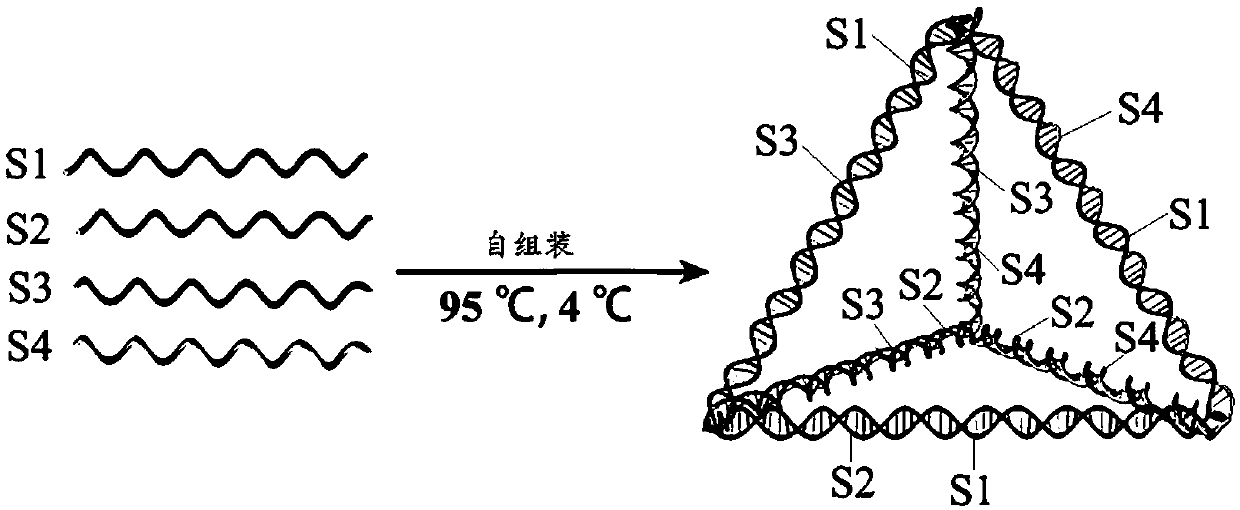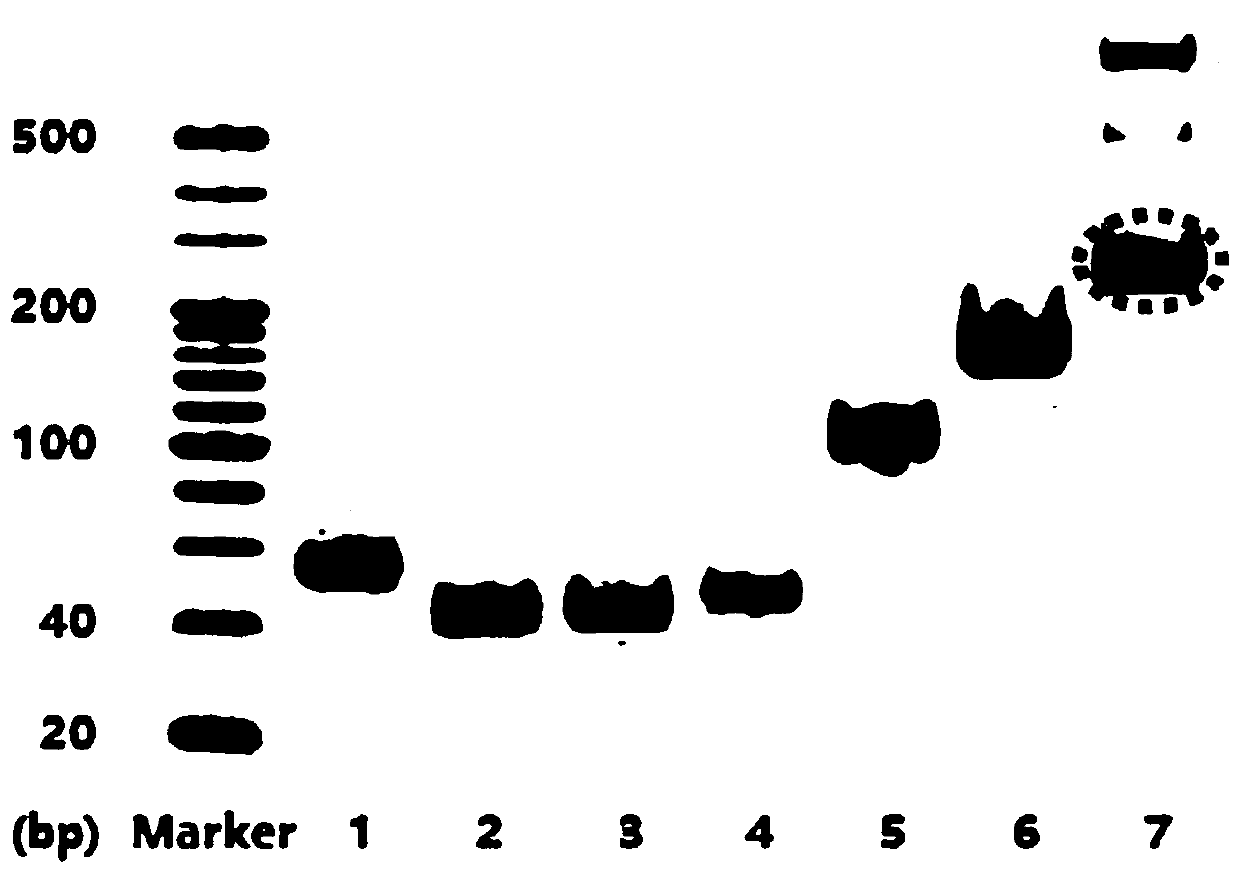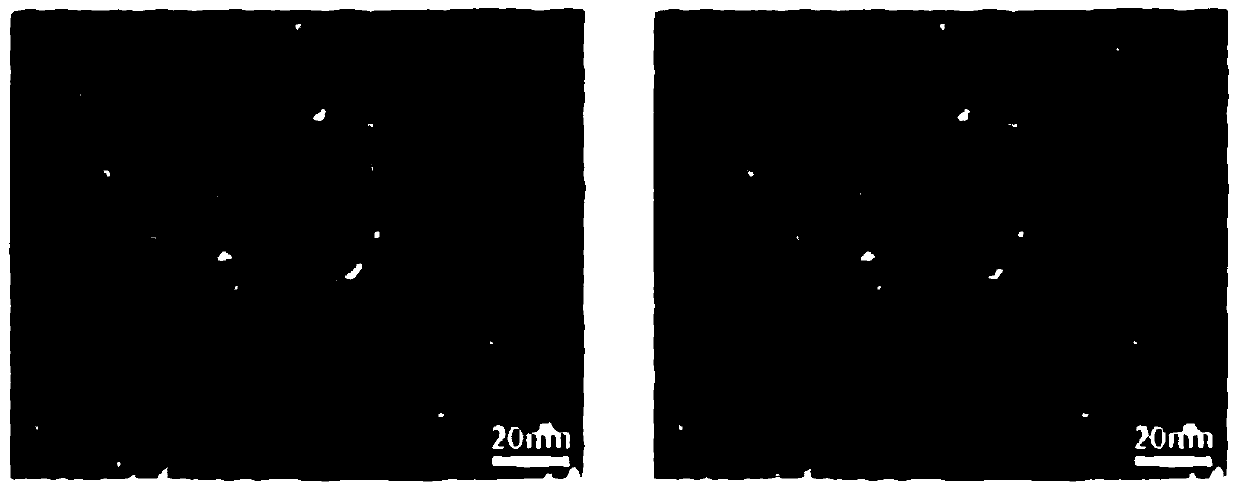Application of DNA (Deoxyribonucleic Acid) tetrahedron to preparation of medicament for promoting neural restoration
A technology of nerve repair and tetrahedron, which is applied in the field of nerve repair, can solve the problems that the application has yet to be developed, and achieve the effect of promoting nerve repair, good biocompatibility, and increasing proliferation
- Summary
- Abstract
- Description
- Claims
- Application Information
AI Technical Summary
Problems solved by technology
Method used
Image
Examples
Embodiment
[0067] Synthesis of Example TDNs
[0068] 1. Synthesis
[0069] Four kinds of DNA single strands (S1, S2, S3, S4) are dissolved in the TM buffer solution with the same final concentration, wherein, the solute of the TMbuffer solution is Tris-HCl and MgCl , and their concentrations are respectively 10mM and 50mM, and adjusted The pH of the solution was 8.0. Then the mixture was vortexed, mixed, and centrifuged, then placed in a PCR instrument, and the temperature was rapidly raised to 95°C and stabilized for 10-15 minutes, then cooled to 4°C and stabilized for 20 minutes. That is synthesized as figure 1 The tetrahedral structure shown.
[0070] The sequence of the DNA single strand is shown in Table 1.
[0071] Table 1 Sequence of TDNs single strand
[0072]
[0073]
[0074] 2. Identification
[0075] 2.1 Gel electrophoresis
[0076] a. Preparation of polyacrylamide gel: 40wt% acrylamide solution, 10×TAE, 10wt% ammonium sulfate solution, distilled water, tetrameth...
experiment example 1
[0087] Experimental Example 1 Identification of Neural Stem Cells
[0088] Immunofluorescence technique was used to identify mouse neural stem cells, once including the following steps:
[0089] A. Inoculate the cell suspension in a confocal small dish and place it in an incubator for 24 hours. Aspirate off the culture medium whose component is DMEM+10% serum+1% double antibody, wash with PBS 3 times, 5 minutes each time;
[0090] B. After fixing with 4% paraformaldehyde for 25 minutes, absorb the paraformaldehyde and wash with PBS 3 times, 5 minutes each time;
[0091] C. Treat with 0.5% Triton-100 for 20-25 minutes, absorb Triton-100, wash with PBS 3 times, 5 minutes each time;
[0092] D. Treat sheep serum for 1 hour, absorb sheep serum, wash with PBS 3 times, 5 minutes each time;
[0093] E. Primary antibody (anti-nestin antibody) treatment, overnight at 4°C. On the second day, rewarm at 37°C for 0.5 hours, recover the primary antibody, and wash with PBS 3 times, 5 min...
experiment example 2
[0098] Experimental Example 2 Neural Stem Cell Uptake Experiment
[0099] Being able to be taken up by cells in large quantities is the prerequisite for most drugs to play a therapeutic role. This experiment example detects the uptake ability of neural stem cells to TDNs.
[0100] (1) Flow cytometry
[0101] a. Inoculate the cell suspension in a 6-well plate, and pre-cultivate it in an incubator for 24 hours (37°C, 5% (v / v) CO2); then reduce the serum concentration in the medium from 10% to 6%, and then Continue culturing in the incubator for 6 hours (37°C, 5% (v / v) CO2); then reduce the serum concentration in the medium from 6% to 0, and continue culturing in the incubator for 1 hour (37°C, 5% (v / v) / v)CO2).
[0102] B, the negative control group does not do any treatment, the positive control group adds the single-stranded DNAS1 that the concentration is the Cy5 modification of 250nM, the TDNs that the experimental group adds the Cy5 modification that the concentration is...
PUM
| Property | Measurement | Unit |
|---|---|---|
| Particle size | aaaaa | aaaaa |
| Aperture | aaaaa | aaaaa |
Abstract
Description
Claims
Application Information
 Login to View More
Login to View More - R&D
- Intellectual Property
- Life Sciences
- Materials
- Tech Scout
- Unparalleled Data Quality
- Higher Quality Content
- 60% Fewer Hallucinations
Browse by: Latest US Patents, China's latest patents, Technical Efficacy Thesaurus, Application Domain, Technology Topic, Popular Technical Reports.
© 2025 PatSnap. All rights reserved.Legal|Privacy policy|Modern Slavery Act Transparency Statement|Sitemap|About US| Contact US: help@patsnap.com



